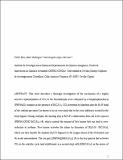Por favor, use este identificador para citar o enlazar a este item:
http://hdl.handle.net/10261/147797COMPARTIR / EXPORTAR:
 SHARE SHARE
 CORE
BASE CORE
BASE
|
|
| Visualizar otros formatos: MARC | Dublin Core | RDF | ORE | MODS | METS | DIDL | DATACITE | |

| Campo DC | Valor | Lengua/Idioma |
|---|---|---|
| dc.contributor.author | Rios, Pablo | es_ES |
| dc.contributor.author | Rodríguez, Amor | es_ES |
| dc.contributor.author | López-Serrano, Joaquín | es_ES |
| dc.date.accessioned | 2017-04-03T10:55:13Z | - |
| dc.date.available | 2017-04-03T10:55:13Z | - |
| dc.date.issued | 2016 | - |
| dc.identifier.citation | ACS Catalysis, 6(9): 5715-5723 (2016) | es_ES |
| dc.identifier.uri | http://hdl.handle.net/10261/147797 | - |
| dc.description.abstract | This work describes a thorough investigation of the mechanism of a highly selective hydrosilylation of CO2 to the formaldehyde level catalyzed by a bis(phosphino)boryl (PBP)Ni(II) complex in the presence of B(C6F5)3. CO2 activation by insertion into the Ni–H bond of the catalyst precursor 2 is shown to occur very easily, because of the trans influence exerted by the boryl ligand. During catalysis, the limiting step is B(C6F5)3 dissociation from the active species (PBP)Ni–OCHO·B(C5F6)3 (4), which controls the amount of free borane that can lead to over-reduction to methane. Free borane activates the silane by formation of [R3Si–H···B(C6F5)3], which can then transfer the silylium (R3Si+) fragment to the oxygen atoms of the Ni formate and Ni acetal intermediates. The ion pair [(PBP)Ni][HB(C6F5)3] (5) is the key species that activates CO2 in the catalytic cycle (and silylformate in a second step) with [HB(C6F5)3]− as the source of hydride. Hydride transfer to [(PBP)Ni–OCO]+ is virtually barrierless, whereas hydride transfer to [(PBP)Ni–OCHOSiR3]+ has the second-highest energy barrier of the process (25.2 kcal mol–1). Therefore, the (PBP)Ni framework is instrumental in both reduction steps of the catalysis and controls the selectivity of the reaction by sequestering B(C6F5)3 | es_ES |
| dc.language.iso | eng | es_ES |
| dc.publisher | American Chemical Society | es_ES |
| dc.relation.isversionof | Postprint | es_ES |
| dc.rights | openAccess | en_EN |
| dc.subject | Boryl ligands | es_ES |
| dc.subject | CO2 | es_ES |
| dc.subject | DFT calculations | es_ES |
| dc.subject | Hydrosilylation | es_ES |
| dc.subject | Mechanisms | es_ES |
| dc.subject | Nickel complexes | es_ES |
| dc.title | Mechanistic Studies on the Selective Reduction of CO2 to the Aldehyde Level by a PBP-Supported Nickel Complex | es_ES |
| dc.type | artículo | es_ES |
| dc.identifier.doi | 10.1021/acscatal.6b01715 | - |
| dc.description.peerreviewed | Peer reviewed | es_ES |
| dc.relation.publisherversion | http://dx.doi.org/10.1021/acscatal.6b01715 | es_ES |
| dc.embargo.terms | 2017-07-20 | es_ES |
| dc.relation.csic | Sí | es_ES |
| oprm.item.hasRevision | no ko 0 false | * |
| dc.type.coar | http://purl.org/coar/resource_type/c_6501 | es_ES |
| item.languageiso639-1 | en | - |
| item.fulltext | With Fulltext | - |
| item.openairecristype | http://purl.org/coar/resource_type/c_18cf | - |
| item.cerifentitytype | Publications | - |
| item.grantfulltext | open | - |
| item.openairetype | artículo | - |
| Aparece en las colecciones: | (IIQ) Artículos | |
Ficheros en este ítem:
| Fichero | Descripción | Tamaño | Formato | |
|---|---|---|---|---|
| ACS Catalysis 2016.pdf | 1,14 MB | Adobe PDF |  Visualizar/Abrir |
CORE Recommender
SCOPUSTM
Citations
56
checked on 20-abr-2024
WEB OF SCIENCETM
Citations
55
checked on 19-feb-2024
Page view(s)
299
checked on 23-abr-2024
Download(s)
341
checked on 23-abr-2024
Google ScholarTM
Check
Altmetric
Altmetric
NOTA: Los ítems de Digital.CSIC están protegidos por copyright, con todos los derechos reservados, a menos que se indique lo contrario.
